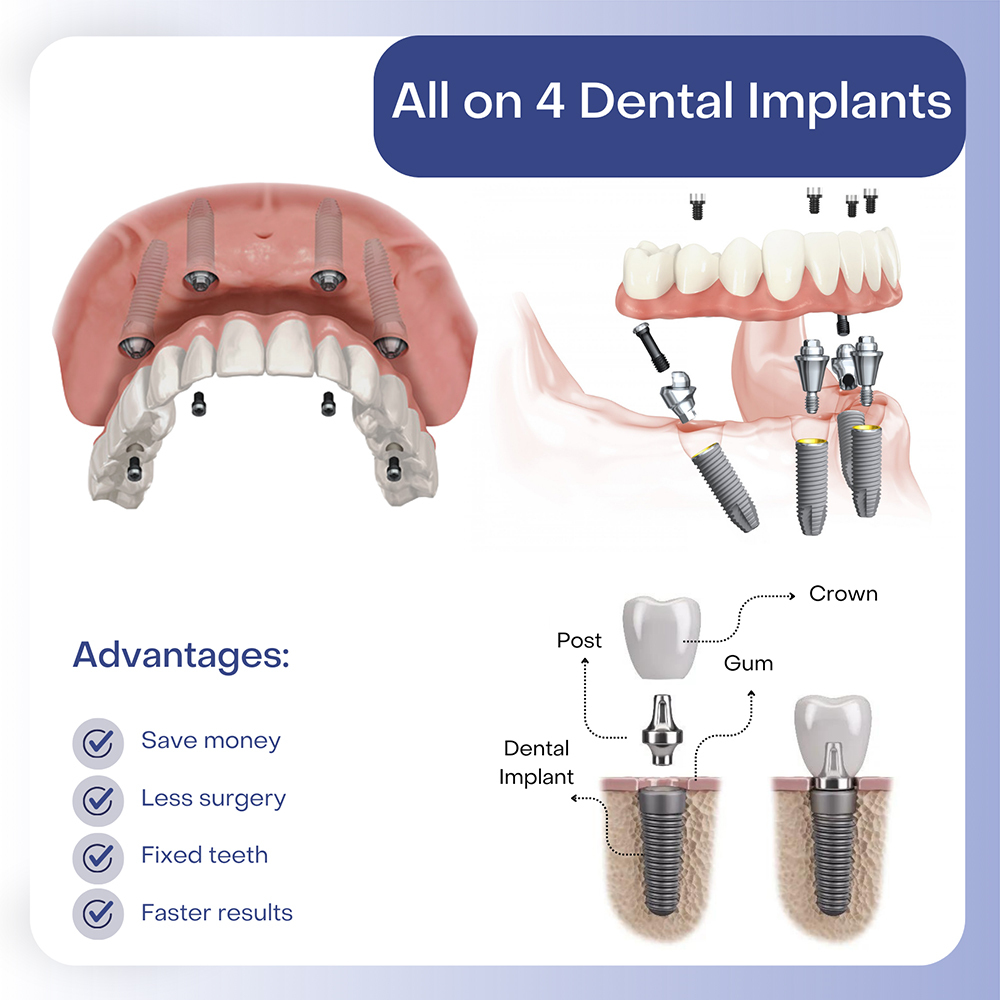Table of contents
All on four dental implant treatment offers a permanent solution for tooth loss using just four implants. It provides patients with a complete arch of teeth firmly fixed in position and which are non-removable. They can only be taken out by a dentist.
Treatment can be a good choice for anyone with complete tooth loss affecting their upper or lower jaw. This tried and tested technique is ideal for patients with less bone density who wouldn’t be suitable for traditional implants without bone grafting.
 All on Four is an innovative treatment developed in the 1990s and is now used worldwide. Instead of requiring multiple implants inserted evenly along the jawbone, the implants are inserted towards the front of the jawbone instead.
All on Four is an innovative treatment developed in the 1990s and is now used worldwide. Instead of requiring multiple implants inserted evenly along the jawbone, the implants are inserted towards the front of the jawbone instead.
The technique is different because of how the implants are angled, increasing contact of the implant posts with the surrounding bone. Longer implant posts can be used so strength and stability increase. Because the implants are inserted towards the front of the mouth, the need for bone grafting is reduced or eliminated. The jawbone is naturally stronger and thicker toward the front of the mouth.
All Four treatment are suitable for anyone who currently wears a full denture or faces a missing full mouth. It is generally used for people with lower denture implants who find them loose and uncomfortable.
Any dental implant treatment requires reasonable dental and medical health, and patients must be over 18 so teeth and jaws have finished growing and developing. Being older is not a barrier to treatment. Treatment is minimally invasive, so it can be suitable for people with conditions like well-controlled diabetes or who have osteoporosis.
Advantages include:
There are a few disadvantages, and treatment will not suit everyone, so seeing a skilled implant dentist is important. Also, All on 4 is a more complex treatment to complete and must be correctly planned so each implant is situated correctly.
The process for having this treatment follows several different phases and can take a few months to complete.
We must evaluate your dental health, including your existing teeth, jaws, and facial muscles. We also review your medical history, and we need to know all medications and supplements currently prescribed and if you have any existing problems that could affect healing, such as autoimmune disorders.
Diagnostic tests include a cone beam CT scan, a 3-D dental x-ray, and possibly digital dental impressions and x-rays to plan treatment further. These images allow us to identify optimal positions for each implant, avoiding all important structures in your jaws.
Once your treatment plan is complete, we create a computer-generated surgical stent that will fit over your gums during surgery, guiding our implant dentist.
Local anesthetic ensures treatment is pain-free. We can also discuss sedation dentistry to help you feel more relaxed and comfortable during treatment.
The surgical stent is fitted over your gums, so our dental implant dentist only needs to make minimal incisions to insert and tighten the implant screws in the pre-identified locations. Once in position, the implants will need several months to heal fully.
A temporary prosthesis can be fitted onto the implants soon after surgery so you can eat and speak confidently, although you must adjust your diet. While your mouth heals, you must stick to softer foods so the implants aren’t placed under too much pressure and can heal properly, becoming firmly fused in your jawbone.
Healing can take 3 to 6 months, after which you will return to our dental office so we can begin making your permanent prosthesis. While your temporary prosthesis should look good, you can rest assured that your permanent teeth will look much better. They are custom-designed in our on-site dental lab to create a natural-looking appearance and will provide good biting strength and functionality.
Generally, this treatment is used to restore a lower arch of teeth. Lower dentures tend to cause more problems than upper dentures as they have less retention since they only cover the ridge of bone that originally supported natural teeth. Upper dentures also cover the upper palate, giving them better suction and stability.
While replacing an upper denture with Al on Four implants is possible, the process can be a little different since the upper jawbone is not the same as your lower jaw. Although just four implants are needed to support a lower arch of teeth, you will almost certainly need six or more implants to support an upper set of teeth securely.
Treatment must be planned accurately because the upper jawbone is near your sinus cavities over the upper back teeth. The jawbone is naturally weaker and thinner in this area and must be avoided or increased with bone grafting.
If you want to replace an upper denture with implants, we can discuss if All on 4 is suitable and whether more implants are needed for greater strength and stability. In this case, you might need a variation of All on 4, called All on 6.
Instead of four dental implants, six are needed to secure the replacement teeth. The extra implants provide additional support and stability, ensuring treatment has an excellent chance of long-term success.
However, because more implants are needed, there is an increased likelihood that bone grafting will be required as the implants extend further toward the back of the mouth, where the jawbone is thinner. The greater number of implants will increase the price. Additionally, two more implants must be cleaned thoroughly, so daily maintenance is a little more time-consuming.
Restoring a complete arch of teeth with an implant prosthesis can be life-changing, particularly for anyone finding it difficult to wear a denture comfortably or interested in a more permanent and stable solution. Well planed restorations have a high success rate and provide good patient satisfaction. All on Four implants problems are low.
When you visit our New Jersey dental clinic, we can review this treatment and assess your dental and medical health, helping you decide whether it is appropriate or another solution may suit you better.

My name is Victoria Kushensky. I am a general dentist dedicated to remaining at the forefront of my field. Combining compassionate care with extensive knowledge, I offer cosmetic and general dentistry services as well as advanced root canal treatments.
I earned my Doctor of Dental Surgery (DDS) degree from the esteemed New York University College of Dentistry. Throughout my career, I have honed my skills in various dental procedures, ensuring effective treatment for each patient’s unique needs. I prioritize patient comfort and understanding, taking the time to thoroughly explain procedures and address any questions.
More about Dr. KushenskyMy NJ Dentist: Victoria Kushensky, DDS
385 Prospect Ave Suite 304
Hackensack, NJ 07601
(201) 298-8000